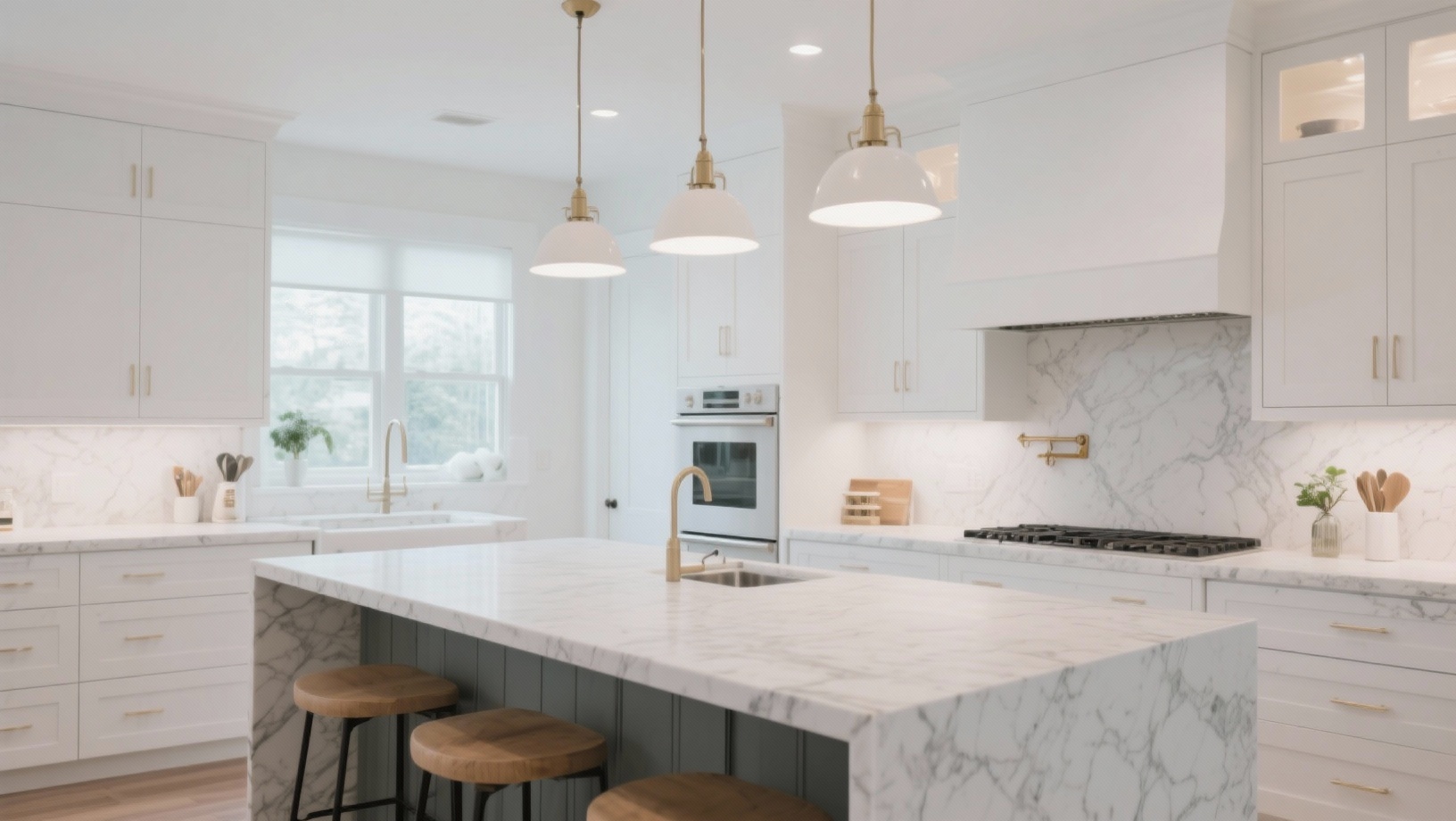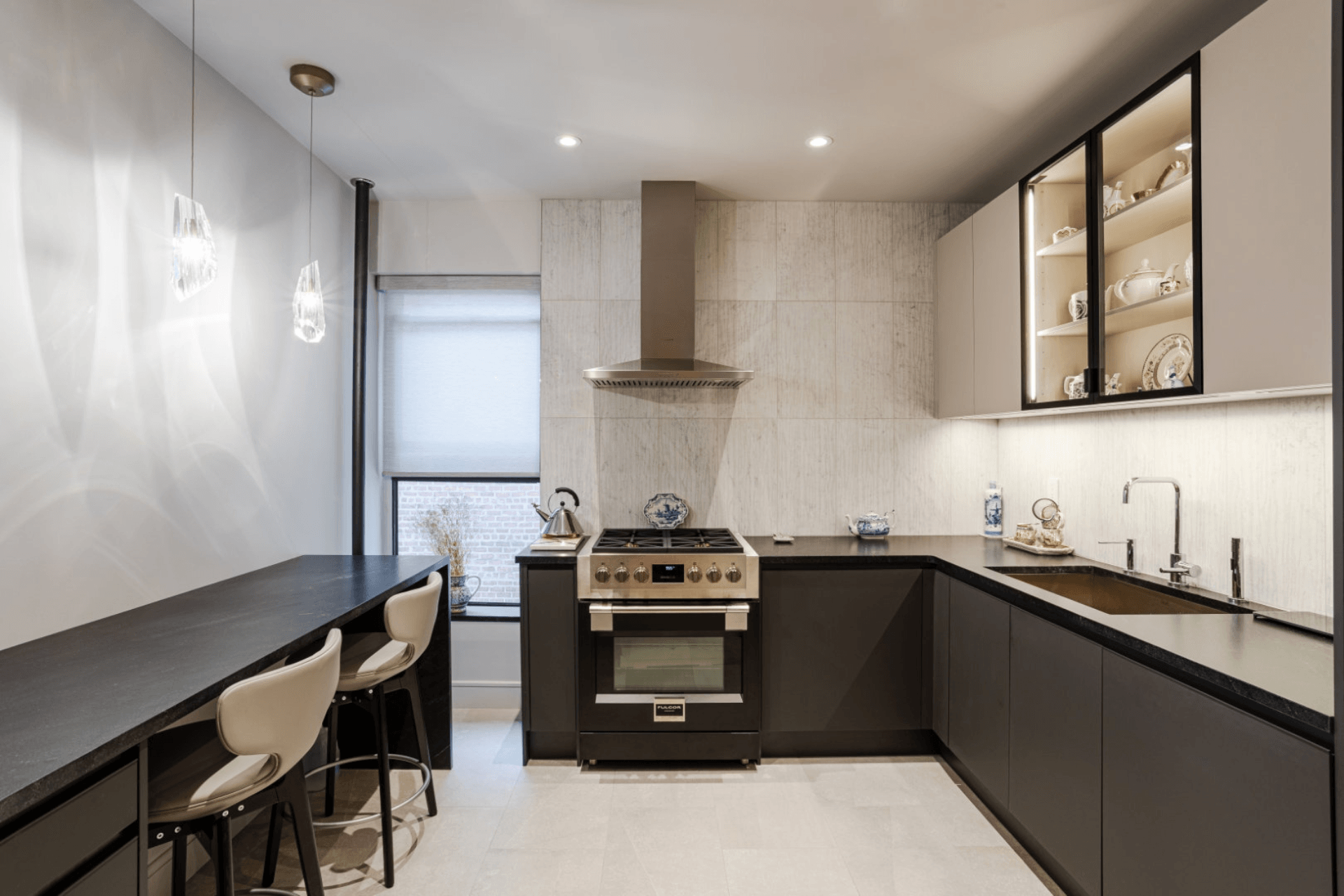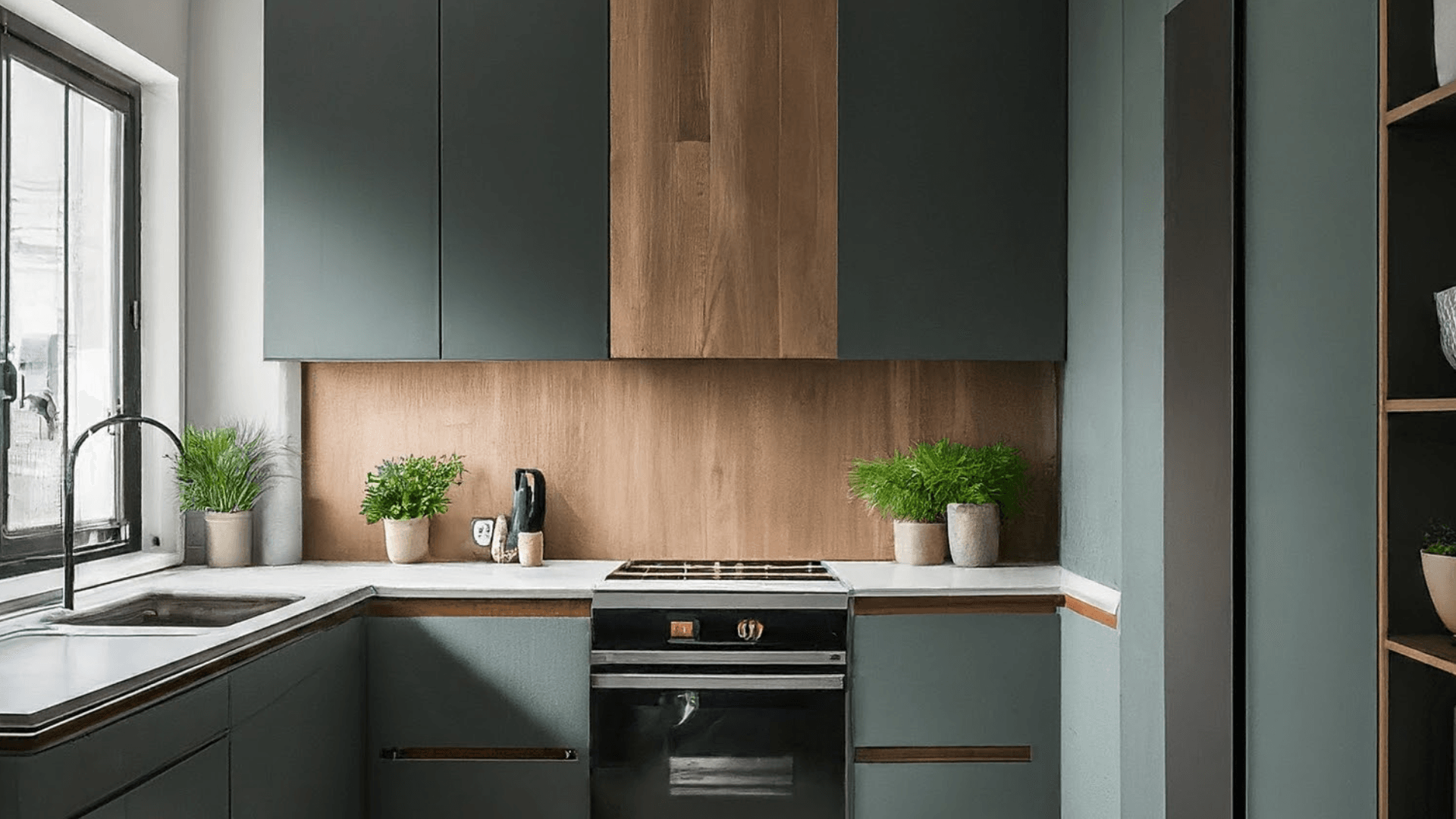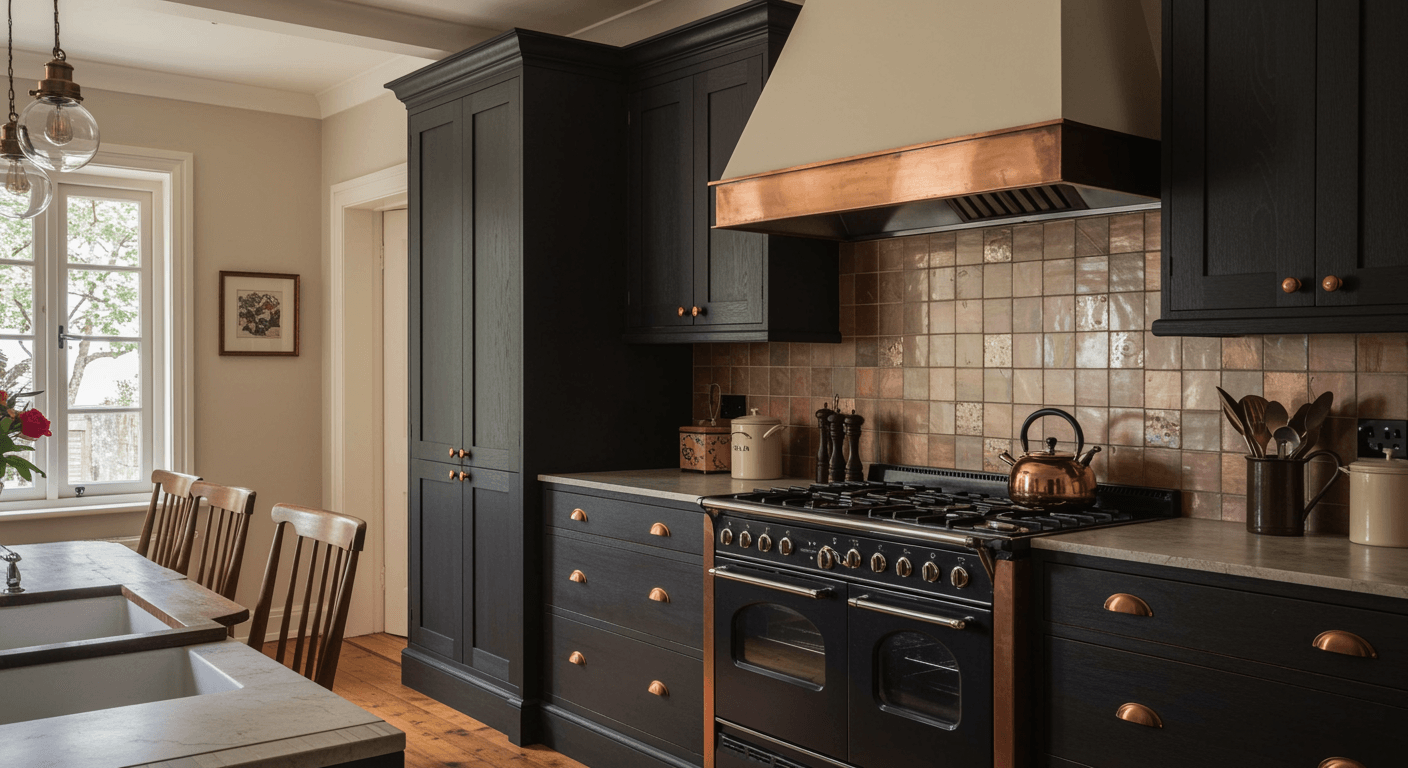The safe kitchen blueprint gives family well-being as well as utility top priority, guaranteeing every corner is carefully created to reduce dangers. A safe setting for little hands is made by childproofing techniques such rounded countertops, strong cabinet locks, and slip-resistant flooring. Families may cook together without sacrificing peace of mind by combining design and safety.
Safe Kitchen Blueprint 1: Layout & Workflow
Safe and effective family kitchens depend on a good design. The work triangle — arranging the refrigerator, sink, and stove triangularly is among the most fundamental concepts. Though maintaining easy access to the most frequently used areas, this design reduces needless movements while cooking.
For households, keeping enough space between these crucial components is essential; a minimum of 42 to 48 inches between counter enables many people to go freely without harming hot surfaces or each other. Open floor plans or U-shaped layouts work well for family kitchens since they provide lot of room for movement while yet preserving the cleanliness of the workplace.
Steer clear of furniture, islands, or overhangs in spots where children often play or in locations where tripping hazards might exist; clear pathways are equally crucial. Apart from increasing productivity, isolating culinary, preparation, and cleaning spaces also boosts safety by lowering the possibility of accidents from cross-traffic between sharp equipment and heated surfaces. Arranging the kitchen with visibility in mind guarantees that adults in homes with small children may quickly keep an eye on their children while cooking or cleaning.
Mobile kitchen carts or islands provide free preparation space without obstructing mobility. First, shaping and flowing in the kitchen helps to build a workable environment where family interaction, cleaning, and cooking can coexist safely, hence facilitating daily routines to run precisely and hence reducing the likelihood of mishaps.
Safe Kitchen Blueprint 2: Child-Friendly & Safe Surfaces

One of the most crucial elements in family-safe kitchen design is material selection since it immediately affects the utility and security of the area. Rounded-edged or bullnosed countertops are great for residences with children since they greatly reduce the chance of falls or unintentional bumps causing injury.
Though they might lead to serious injuries or bruises particularly for young youngsters and toddlers investigating the area, sharp angles are customary in classic kitchen designs. Apart from providing a strong workstation, heat-resistant materials like quartz, granite, or Silestone reduce the possibility of fires or surface damage caused by heated pans and pots.
@ampquartzcabinets WOWW, 11.11 BIG SALE?! 😱‼️ 📅 From 1 November – 11 November 2025 Jom datang ke AmpQuartz untuk nikmati : 📌 Cash Rebate RM1,000 📌 Exclusive Mysterious Gift 📌 11% Discount Off 📌 11 Free Gift (worth RM3,000+) Limited untuk 11 orang terawal sahaja 🥳🥳 #AmpQuartz #KitchenCabinet bigsale11.11 #NovemberPromo #fullhousepackage
♬ Energetic Inspiring Upbeat Funk(1091157) – respectrum
Non-slip flooring is especially crucial in areas where drips are likely around sinks, ovens, or burners. Simple-to-clean and maintain surfaces like rounded sinks, seamless countertops, or backsplash panels devoid of complicated grout lines also help to keep cleanliness and so reduce the possibility of bacterial growth, particularly important in family kitchens. Textured or matte finishes therefore offer a safer environment for adults as well as kids by reducing slips and falls.
These child-friendly surfaces, right appliance placement, and office design ensure a kitchen is inviting, very functional, and safe for daily family activities. First and foremost, these assist parents in creating a kitchen environment in which little risk allows youngsters to move, learn, even help in meal preparation — so fostering family involvement as well as safety.
Safe Kitchen Blueprint 3: Safety Tech & Extras
Designing a family-friendly kitchen with real extras and safety systems is necessary to provide a secure environment for both children and adults. Additionally assisting in the mitigation of hazards this will be beneficial. Early warnings in the event of a fire or gas leak come from smoke and carbon monoxide detectors which should be put purposefully close to cooking surfaces and equipment.
Though they are easily available, fire extinguishers ought to be kept out of little children's reach with simple instructions for quick use in cases of need. Among contemporary safety features are stove guards, anti-tip range brackets, and smart induction cooktops which automatically shut off when not in use hence lowering the danger of burns or accidental fires.
Smart sensors and water leak detectors warn homeowners of potential dangers, hence preventing slips, water damage, or electrical accidents. Under-cabinet lighting and task lighting improve visibility, so ensuring safer food preparation; touch-less faucets lower cross-contamination and provide more easy handwashing. Access to knives, cleaning materials, or little electronics that could be dangerous is restricted by locks on cupboards and drawers designed for children.
Small changes including heat-resistant mats, anti-slip carpets, and corner guards for countertops assist to boost general safety. Families who deliberately integrate these safety equipment and useful extras may build a kitchen that encourages daily activity, inspires children to cook conscientiously, and provides peace of mind all without compromising appearance or performance.
Safe Kitchen Blueprint 4: Cleaning & Hygiene

The maintenance of both health and safety in a family-friendly kitchen is defined by cleanliness and hygiene. Surface choice is one of the most critical elements. Rounded sinks and smooth countertops like quartz or Silestone help to close gaps where bacteria and dust might thrive, hence improving daily cleaning efficiency and lowering pollution risk.
Touch-less faucets, another contemporary development for sanitation, let family members wash hands or rinse food without really touching knobs — really useful while working with raw food. Good drainage and splash guards thereby reduce electrical hazards by stopping water from pooling near to electrical outlets or cooking surfaces and also lower falling risk.
@ampquartzcabinets 5 jenis aksesori yang perlu pasang di dapaur! Korang rasa sebab apa? Semuanya ada dalam video ni! 😍😆 #AmpQuartz #KitchenCabinet #aksesoridapur #fyp
♬ original sound – AmpQuartz – AmpQuartz
To inspire cleanliness, storage solutions should also be implemented; pull-out cabinets and drawers assist in keeping parts off the floor; dedicated tall cabinets for chemicals prevent accidental mixing of dangerous substances with food. Proper placement of recycle and trash cans also guarantees garbage containment; frequent oven, microwave, and refrigerator cleaning schedules prevent grease and bacterial buildup.
Under-cabinet and task lights can improve visibility even more, therefore allowing for simpler identification of spills or mishaps requiring attention. For homes, teaching simple habits such hand washing before meals, counter wiping after usage, cutting board and utensil cleaning is as crucial as the design itself. Innovative materials, simple storage, and family-friendly habits help the kitchen be a neat and safe area for all of its members.
Safe Kitchen Blueprint 5: Encourage Family Participation Safely
Though it has to be handled with care, encouraging family participation in the kitchen creates harmony, gives priceless life lessons, and enables to create enduring memories. Designated spaces for children to safely assist in food preparation define a family-safe kitchen; these could be little counters, simple activity tables, or unique children's corners with child-friendly silverware and instruments.
These environments let kids connect freely by cut, burn, or reach. Making higher cabinets more readily available, pull-down shelves and step stools foster independence and so lower the probability of recorded injuries. Soft-close cabinets and drawers assist in minimising finger injuries; induction cooktops, oven locks, and stove barriers protect burns.
Parents can teach kids early on about safe behaviour including correct knife use, oven mitt worth, and fast spill cleanup to avoid injuries. Although non-slip flooring ensures a safe movement scenario, well planned corridors provide visibility via task lighting over desktops.
Strict safety codes, ergonomic design, and ordered storage transform the kitchen into a space where youngsters are urged to help and study and adults may cook successfully without constant effort. In addition to improving relationships, this form of family involvement fosters self-confident and responsible kids hence transforming the kitchen into a fantastic and safe hub of everyday living.





